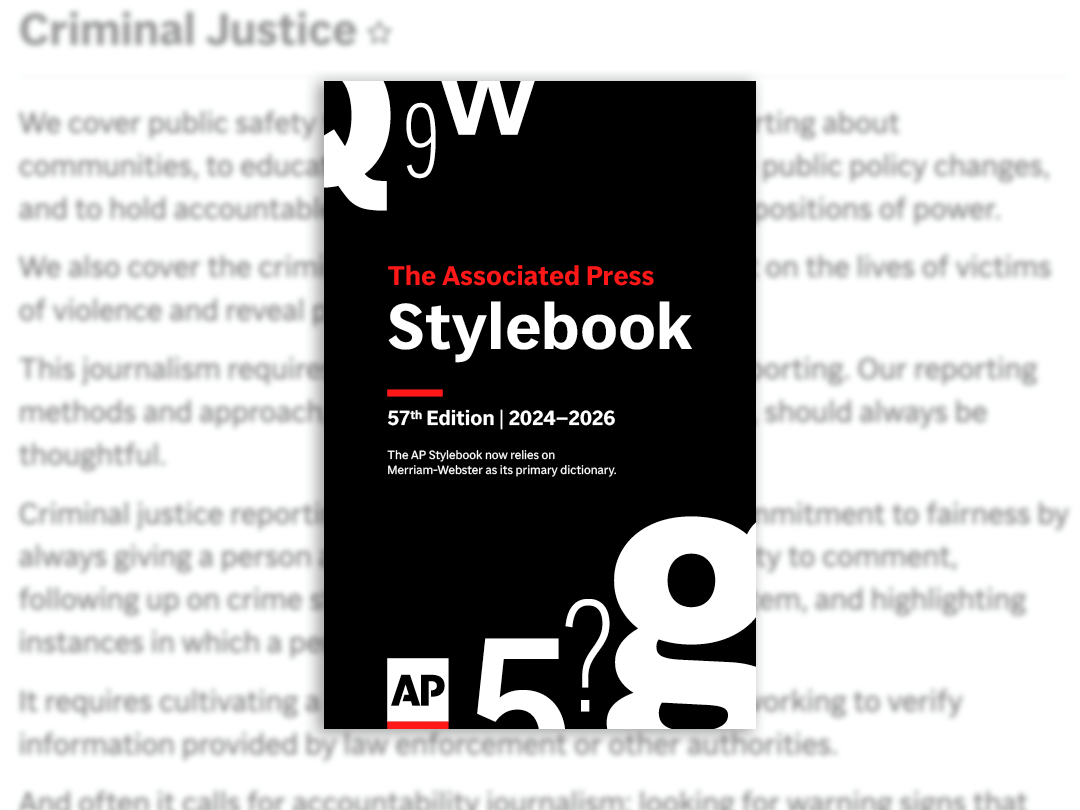It probably won’t dominate Goodreads lists or lead The New York Times Book Review’s most anticipated titles, but The Associated Press’ newly arrived print update will have style wonks taking note and flipping (or clicking) pages.
The AP, which has published a stylebook since 1953, released the book’s 57th edition May 29. The organization announced several changes and updates, by tradition, at the Society for Editing’s annual conference, which this year was in early April in San Diego. On May 29, the AP announced the release of the updated print book and subscription website and highlighted the book’s new criminal justice section.
The new edition’s bombshell shift, which brought cheers from Society for Editing conference attendees, involved dictionaries — a switch from Webster’s New World Dictionary to Merriam-Webster. Stylebook editor Paula Froke announced the news, flanked by Merriam-Webster editor-at-large Peter Sokolowski.
The new dictionary was installed online for subscribers May 29. In its press statement, the AP said, the stylebook and dictionary are warp and woof in weaving the guidance journalists follow.
“Merriam-Webster has long been a tremendous resource for us, even when it wasn’t our official dictionary. Its editors respond quickly and nimbly to shifts in usage and style,” Froke said in an email to Poynter. “Like the AP Stylebook, Merriam-Webster reflects today’s world. Its editor at large, Peter Sokolowski, and I have already consulted many times and we have an excellent working relationship that will serve us and Stylebook users very well. Our style and that of Merriam-Webster is largely aligned, and our philosophies are very similar”
The new criminal justice chapter, written by AP criminal justice reporters and editors, with support from the criminal justice-reporting-focused Public Welfare Foundation, includes more than 50 entries covering specific terms, some new, some revised.
Kelly McBride, a Poynter senior vice president who teaches Poynter’s course Transforming Local Crime Reporting Into Public Safety Journalism, is among the sources the new stylebook chapter cites.
In a May 29 statement, the AP said the new chapter emphasizes the need for accountability journalism and encourages reporters and editors covering crime stories to watch how law enforcement responds, look for missed warning signs and contemplate ways to stop crime from recurring.
Here are notable criminal justice chapter changes.
An update on assault weapons
Although the AP’s earlier books had advised avoiding “assault weapon” or “assault weapons,” both terms are now allowed in headlines and body copy first references because, it said, “This how this group of firearms has become commonly known.” Stories using the terms should include specifics when possible; as the stylebook entry says, “Certain semiautomatic rifles referred to as assault weapons, or certain semiautomatic rifles commonly called assault weapons.”
A juvenile, minor entry outlining the terms’ problems
“Juvenile and minor are broad terms that can carry legal connotations when sometimes there are none … The terms’ clinical tone can inadvertently suggest guilt in situations of crime or conflict,” the entry reads. “They can be dehumanizing. They can be perceived as having racial connotations. Their definitions can vary across jurisdictions.”
An entry for prison, jail, prisoner, inmate, incarcerated person
As in previous editions, the AP distinguishes prisons from jails, terms that are neither synonymous nor interchangeable.
Broadly, prisons are typically run by states, the federal government or private companies and usually confine people serving sentences of more than a year.
Jails, usually run by local authorities such as a city or county, normally confine people serving sentences for lesser crimes and for less than a year; people awaiting trial or sentencing on either felony or misdemeanor charges; and people confined for civil matters such as failure to pay alimony.
The AP emphasizes using person-first language to describe imprisoned people, e.g., “a man who is incarcerated in an Alabama prison is appealing his sentence” instead of “a state prison inmate is appealing his sentence.”
The book has a new entry on sex work and prostitution, which the AP says are fine as broad umbrella terms for describing sex exchanged for goods or money — legal or not. But the AP encourages reporters and editors to use specifics when describing people working in these industries — prostitute, dancer, stripper, porn performer, online performer.
In an influential micro-level change, the AP revised its prefix guidance.
Although the stylebook had moved away from prefixes with hyphens in previous editions, this 57th rendition emphasizes that hyphens are now gone with out-, post-, pre- and re-. So, describing the time before and after the height of COVID-19 would be prepandemic and postpandemic.
Also, the hyphens in semiautomatic and semiautonomous dropped, aligning with other semi- words (semicircular, for example).
Here are prefix rules of thumb:
- Use a hyphen if the prefix ends in a vowel and the word following begins with the same vowel. Exceptions: cooperate, coordinate, and double-e combinations such as preestablish, preeminent, reenact, and especially notable this year, reelect.
- Use a hyphen if an uppercased word follows, e.g. un-American, mid-Atlantic.
- Use a hyphen to join doubled prefixes: sub-subparagraph.
Other highlights in the new edition include
- Wider climate change guidance covering use of “climate crisis” and adding entries for community solar, energy transition geothermal, hydrogen and lithium ion.
- Updated guidance on the terms Native Americans, Indigenous people(s) and American Indians.
- Updated guidance on obesity.
- The new books also include a new chapter on artificial intelligence, introduced online last August, written by reporters covering AI and experts in the field.
- A new checklist on self-editing and writing, new to the print books but previously online. “I think (the checklist) is more valuable than ever in these days of smaller and smaller newsrooms and more one-person shops,” Froke said.
Looking ahead to 2025, Froke said she and her team will keep addressing big-picture topics and mechanics including grammar, punctuation and capitalization.
Although the AP’s sometimes shifting style is about words and not clothes, the organization said keeping up with trends matters either way.
“Fashion writers tell us skinny jeans are out and flare leggings are in,” the AP wrote on Instagram. “We aren’t here for a fit check, but we are here to make sure you’re up to date on your AP style.”







